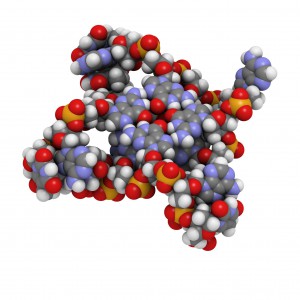
The POT1 protein plays a critical role in telomere protection and telomerase regulation. POT1 binds single-stranded 5′-TTAGGGTTAG-3′ and forms a dimer with the TPP1 protein. Human POT1 contains two Oligonucleotide/Oligosaccharide Binding (OB) fold domains, OB1 and OB2, which make physical contact with the DNA. OB1 recognizes 5′-TTAGGG whereas OB2 binds to the downstream TTAG-3′ (1,2). Several recent studies from other species have shown that some of these proteins are able to recognize a broader variety of DNA ligands than expected (3). A recent reference reexamined the sequence-specificity of the Human POT1 protein (4).
SELEX (Systematic Evolution of Ligands through Exponential Enrichment) was used to re-examine the DNA-binding specificity of human POT1 (5).
A brief summary of the experimental design is follows: A 75-mer single-stranded (ss) oligonucleotide containing a 35-nt random core flanked by PCR priming sequences was used as starting material. In the first round of selection, this randomized oligo was incubated with rabbit reticulocyte lysate containing the expressed Flag-POT1 and binding buffer. After 30 minutes at room temperature, magnetic beads coated with the anti-Flag M2 antibody were added. After an hour of rotation at 4 °C, the beads were washed in binding buffer, after which the selected oligos were eluted at 95 °C for 5 minutes in a PCR mix. Re-amplification of the eluted molecules was done with Taq DNA polymerase. Aliquots taken after 10, 15, 20 and 25 cycles of PCR were analyzed by electrophoresis. The most optimally amplified DNA product was excised and gel purified. To regenerate the ssDNA molecules needed for the next round of SELEX, the isolated DNA was subjected to 16 cycles of asymmetric PCR with Taq DNA polymerase and the forward primer alone. Additional rounds of SELEX were performed identically
to the first round. After the sixth round of selection, the reamplified and gel-purified double-stranded DNA was cloned into TA-cloning vector. A total of 50 colonies were picked and analyzed by sequencing.
Through the successive capture of POT1/DNA complexes, two classes of high-affinity POT1 ligands were identified from a pool of randomized ssDNA molecules by SELEX. One class corresponded to the cognate telomeric binding site of human POT1 made of juxtaposed OB1- and OB2-binding motifs (5′-TTAGGGTTNG-3′, where N is any nucleotide). The second, more abundant class instead combined an OB1-binding motif (5′-TTAGGN-3′) with a novel non-telomeric DNA motif (5′-TNCANNAG-3′). In vitro binding studies confirmed the high affinity interaction of human POT1 with these non-telomeric binding sites. This capability of human POT1 to recognize non-telomeric sequences raises the possibility that the protein might play additional roles at non-telomeric locations.
Additional experiments were also conducted to further characterize the binding of human POT1 to the DNA sequences these included: Generating mutations in POT1 protein to determine protein domains required for binding, expression of POT1 in E.coli to access the requirement for associated factors in POT1 binding and the effect of POT1 as a heterodimer with TPP1 on binding.
Literature Cited
1. Baumann, P. et al. (2001) Pot1, the putative telomere end-binding protein in fission yeast and humans. Science 292, 1171–75.
2. Lei, M. et al. (2003) DNA self-recognition in the structure of POT1 bond to telemetric single-stranded DNA. Nature 426, 198–03.
3. Altschuler, S.E. et al.(2011) Schizosaccharomyces pombe protection of telemeres utilizes alternative binding modes to accommodate different telomeric sequences. Biochemistry 50, 7503–13.
4. Choi, K. et al. (2015) The OB fold domain of human POTA recognizes both telomeric and non-telomeric DNA motifs. Bichimie 115, 17–27.
5. Ouellette, M. M. et al. (1995) Use of reiterative selection for defining protein-nucleic acid interactions. Curr. Opin. Biotechnol. 665–72.
